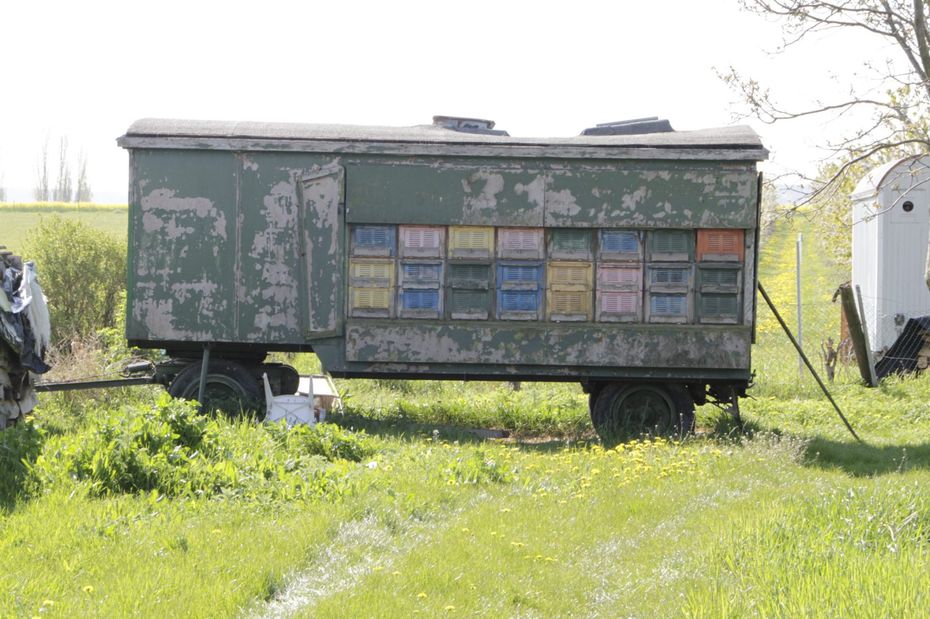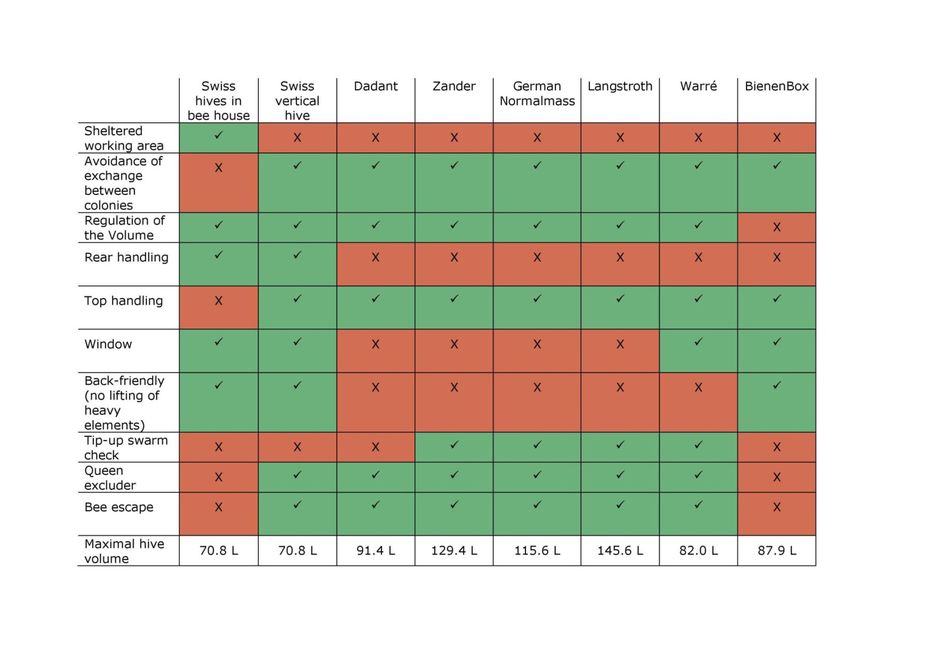Anyone who wants to start beekeeping is faced with numerous choices. Should you go for a bee house or an outside hive? Horizontal or vertical hives? Single or double brood chambers? Each system has its advantages and disadvantages and is adapted to different needs. Navigating your way through this jungle of offers is not easy. Therefore, we have compiled an overview of the pros and cons of various hive boxes for you.
This is how you find the right hive box!
Bee house or outside hive?
The first decision that has to be made is between a «bee house» or an outside location. A bee house provides the beekeeper with a dry, weather-protected working and storage space. Additionally, one is better protected from the bees. Roof windows and «bee windows» allow flying bees to leave the bee house quickly. As a result, inspections can done in a relatively calm environment. In particular for biological oriented beekeepers, this can be an advantage, as it eases close and attentive management of the colony. On top of this, a bee house gives the bees some extra insulation, which also has a positive influence on the honey quality (lower water content, read more about this in our article on honey harvest here).
The disadvantages are the high initial costs, the required building permit and the fixed location. Although the latter two could be bypassed with a so-called «bee trailer» (see Klaus Huber company in Cham). Nevertheless, bee houses have to be maintained and cleaned. Often the bee hives are arranged in two rows above each other, because of this the hives are not situated at optimal working height. If this too inconvenient, the bee house needs to be reconstructed to place the bees at just one, but comfortable height. Another disadvantage of a bee house is the small distance between the colonies, which promote exchange (e.g. robbing) of bees between colonies. Through exchange between colonies, diseases can quickly spread to the whole apiary.
Compared to a bee house, an outside hive has the advantage that it does not require a building permit and can be set up anywhere with the consent of the landowner. They are easy to move, maintain and clean. However, the beekeeper is exposed to the bees and the weather, there is no room to store any materials and the colonies are not protected against theft. On the plus side, these stand-alone hive systems can be set up at some distance from each other, reducing the exchange of bees between different colonies.

Top or rear handling?
A bee house allows for handling of the hives from the rear, however there are also some outside hive boxes on the market with rear handling. At the same time, some bee houses may be designed for hives boxes with top handling. In this instance, the hives are arranged in a row with a window on top. Here, the skylight ensures good visibility when working with the colonies.
Rear handling is generally more time-consuming and can be very cumbersome in some cases (e.g. a quick inspection of a particular comb). The use of a «queen excluder» is critical by rear handling and for varroa control. Further, an extra grid has to be inserted for varroa diagnosis. On the other hand, the window and the look under the combs gives an impression of the state of the colony without opening the hive. Further, the brood combs are easily adapted to the strength of the colony, which support the bees by the temperature regulation of the hive.
Horizontal or vertical hives?
For free-standing hive systems, a distinction between horizontal and vertical hives can be made. Vertical hives (e.g. Swiss-Vertical hives, Dadant, Zander and German ‘Normalmass’) consist of multiple stackable elements which can be divided into brood and honey compartments. The living-space for the bees is adapted in accordance with the seasonally changing strength of the colony. Additionally, by separating the brood and honey compartments with a queen excluder, swarm prevention and nucleus colonies are relatively easy to manage with vertical hives.
Horizontal hives on the other hand (e.g. Golzbeute, Bremerbeute, Bienenbox, Einraumbeute of Mellifera e.V., Topbar Hive), all have the brood and honey combs in one or two rows. Usually the box cannot be expanded. These systems are not designed to maximize honey yield, but working with them is very comfortable for your back, as no heavy frames need to be lifted.
Divided or single brood chambers?
In the case of vertical hives, a distinction must be made between hives with a separated brood area and single brood area. Those with a single brood chamber (e.g. Dadant, 1.5 Zander, 1.5 German-Normalmass) are easier to inspect and the inspection is also carried out more quickly. In addition, the temperature regulation with single brood chambers is easier for the bees. This is why some beekeepers probably report a better colony development in spring. A disadvantage is that vertical hives with a single brood chamber have different frame dimensions (as the brood frames are larger then the honey frames) and the combs cannot be exchanged between the brood and honey chamber.
On the other hand, in systems with a double brood chambers, all frames have the same height. In addition, the tip-up swarm check can be used to control the colonies on swarm cells. By lifting the upper brood chambers you get a view into the center of the brood area. Another advantage of the double brood chamber is the honeycomb renewal in spring. As the bees naturally move from the lower to the upper brood area during winter, the lower half can be completely removed in spring and new frames with fresh comb structures can be added. The disadvantage of the double brood chamber is the heavy lifting of the frames and a reduced overview during inspections.
Small or large brood chamber?
The different hives differ not only in expandability and the type of brood chambers, but also in its maximum size. 10 combs are regarded as optimal, but depending on the hive this corresponds to a different volume. Basically, colonies swarm more often in small brood chambers. Large colonies also have the advantage of supplying a lot of honey with the same amount of work. However, the bees themselves prefer a nest size of 30 to 60 liters. This is because the bees themselves have little benefit from excessively large nests. Firstly the temperature regulation is more difficult to manage. Secondly, swarming is quite in their interest. It not only is the natural reproduction process of the bees, swarms can also reduce the disease pressure (often swarming colonies have less disease such as varroa).
Plastic or wood?
Many hive systems can be bought in either wood or plastic. Wood resembles natural nest construction in hollow trees best. It is also a natural product, breathable and easy to clean (heat-resistant, mechanically robust). However, it is not weatherproof and due to its high weight, the frames are heavy to lift. Plastic, on the other hand, is lighter, weather-resistant and insulates well. However, it is more difficult to clean, not breathable and also not approved for organic beekeeping.
Already decided?
Choosing the right hive is not an easy decision, as it has a large influence on the beekeeping practice. We hope that we have provided you with an overview of the advantages and disadvantages of the different hives. Being a good beekeeper is possible with all systems, which hive is suitable for you, depends on your own needs and beekeeping practice.

Literature
1. Bienefeld, K. (2016). Imkern Schritt für Schritt. Franckh-Kosmos.
2. Brägger, J., Sprecher, E., Lehnherr, M., Fluri, P., Pickhardt, A., Imdorf, A. et al. (2014). Das schweizerische Bienenbuch – Imkerhandwerk. VDRB.